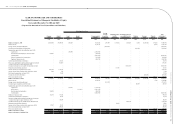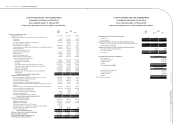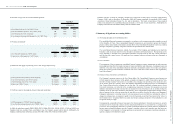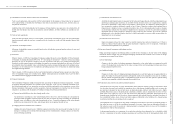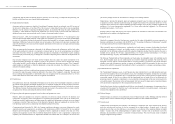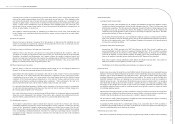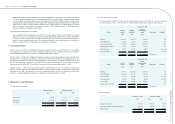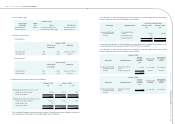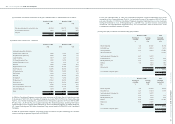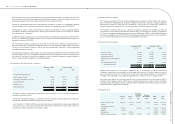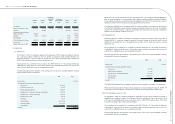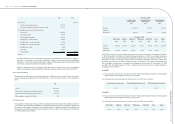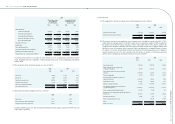Acer 2009 Annual Report Download - page 41
Download and view the complete annual report
Please find page 41 of the 2009 Acer annual report below. You can navigate through the pages in the report by either clicking on the pages listed below, or by using the keyword search tool below to find specific information within the annual report.
If treasury stock is retired, the weighted-average cost of the retired treasury stock is written off to offset the par
value and the capital surplus premium, if any, of the stock retired on a pro rata basis. If the weighted-average
cost written off exceeds the sum of the par value and the capital surplus, the difference is accounted for as a
reduction of capital surplus ‒ treasury stock, or a reduction of retained earnings for any deciency where capital
surplus ‒ treasury stock is insufcient to cover the difference. If the weighted-average cost written off is less
than the sum of the par value and capital surplus, if any, of the stock retired, the difference is accounted for as an
increase in capital surplus ‒ treasury stock.
The Company’s common stock held by its subsidiaries is accounted for as treasury stock. Cash dividends paid
by the Company to its consolidated subsidiaries that hold the treasury stock are accounted for as capital surplus
‒ treasury stock.
(18) Revenue recognition
Revenue from sales of products is recognized at the time products are delivered and the signicant risks and
rewards of ownership are transferred to customers. Revenue generated from service is recognized when the
service is provided and the amount becomes billable.
(19) Employee bonuses and directors’ and supervisors’ remuneration
Employee bonuses and directors’ and supervisors’ remuneration appropriated after January 1, 2008, are
accounted for according to Interpretation (2007) 052 issued by the Accounting Research and Development
Foundation. According to this Interpretation, the Company estimates the amount of employee bonuses and
directors’ and supervisors’ remuneration and recognizes it as operating expense. Differences between the amount
approved in the shareholders’ meeting and recognized in the nancial statements, if any, are accounted for as
changes in accounting estimates and recognized in prot or loss.
(20) Share-based payment transactions
Effective January 1, 2008, the Consolidated Companies adopted SFAS No. 39 “Accounting for Share-based
Payment” for its share-based payments granted on or after January 1, 2008.
Equity-settled share-based payments are measured at fair value at the date of grant. The fair value determined
at the grant date of the equity-settled share-based payments is expensed over the vesting period, with a
corresponding increase in equity. The vesting period is the period during which all the specified vesting
conditions of the share-based payment arrangement are to be satisfied. Vesting conditions include service
conditions and performance conditions (including market conditions). When estimating the fair value of an
equity-settled share-based award, only the effect of market conditions is taken into account.
For cash-settled share-based payments, a liability equal to the portion of the services received is recognized at
its current fair value determined at each balance sheet date and at the date of settlement, with any changes in the
fair value recognized in prot or loss of the period.
Fair value of share-based award is measured using the Black-Scholes or the binomial option pricing model,
taking into account management’s best estimate of the exercise price, expected term, underlying share price,
expected volatility, expected dividends, risk-free interest rate, and any other inputs to the model.
(21) Administrative expenses
The Company’s administrative expenses include direct expenses incurred for the business unit within the
Consolidated Companies and expenses incurred for managing the investee companies. To reect the operating
income of the Consolidated Companies, administrative expenses are divided into two parts. The first part,
representing the direct expenses incurred for the Consolidated Companies, is included as administrative expenses
in the accompanying consolidated statements of income. The second part, representing expenses incurred for
managing the investee companies, is presented as a reduction of net investment income (loss) in the consolidated
statements of income.
(22) Retirement plans
(a) Dened benet retirement plans
Pursuant to the ROC Labor Standards Law, the Company and subsidiaries located in the Republic of China
established individual noncontributory defined benefit retirement plans (the “Plans”) and retirement fund
administration committees. The Plans provide for lump-sum retirement benets to retiring employees based
on length of service, age, and certain other factors. The funding of retirement plans by the Company and
subsidiaries located in the Republic of China is based on a percentage of employees’ total salaries. The funds
are deposited with Bank of Taiwan or other banks.
For the dened benet retirement plan, the Consolidated Companies recognize a minimum pension liability
equal to the amount by which the actuarial present value of the accumulated benet obligation exceeds the
fair value of the retirement plan’s assets. The Consolidated Companies also recognize the net periodic pension
cost based on an actuarial calculation.
(b) Dened contribution retirement plans
Starting from July 1, 2005, pursuant to the ROC Labor Pension Act (the “New System”), employees who
elected to participate in the New System or commenced working after July 1, 2005, are subject to a dened
contribution plan under the New System. For the dened contribution plan, the Company and subsidiaries
located in the Republic of China contribute monthly an amount equal to 6% of each employee’s monthly
salary to the employee’s individual pension fund account at the ROC Bureau of Labor Insurance.
Most of the Company’s foreign subsidiaries adopt defined contribution retirement plans. These plans are
funded in accordance with the regulations of their respective countries.
Contributions for the dened contribution retirement plans are expensed as incurred.
(23) Income taxes
Income taxes are accounted for under the asset and liability method. Deferred income tax is determined based on
differences between the nancial statements and tax basis of assets and liabilities using enacted tax rates in effect
during the years in which the differences are expected to reverse. The income tax effects resulting from taxable
temporary differences are recognized as deferred income tax liabilities. The income tax effects resulting from
deductible temporary differences, net operating loss carryforwards, and income tax credits are recognized as
deferred income tax assets. The realization of the deferred income tax assets is evaluated, and if it is considered
more likely than not that the asset will not be realized, a valuation allowance is recognized accordingly. When
the income tax rate changes due to income tax law revision, the Company recalculates the deferred tax assets
and liabilities using the new tax rate and any resulting variances are recognized as income tax expense or benet
of continuing operating segment.
Classication of the deferred income tax assets or liabilities as current or noncurrent is based on the classication
of the related asset or liability. If the deferred income tax asset or liability is not directly related to a specic asset
or liability, then the classication is based on the asset’s or liability’s expected realization date.
The investment tax credits granted for purchases of equipment, research and development expenses, and training
expenses are recognized using the ow-through method.
According to the ROC Income Tax Act, undistributed earnings, if any, earned after June 30, 1997, are subject to
an additional 10% retained earnings tax. The surtax is accounted for as income tax expense in the following year
when the stockholders decide not to distribute the earnings.
(24) Earnings per common share
Basic EPS are computed by dividing net income by the weighted-average number of common shares outstanding
Acer Incorporated 2009 Annual Report
76.
Acer Incorporated 2009 Annual Report
77. Financial Standing





